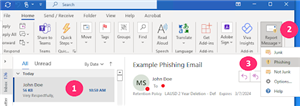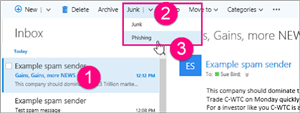- Los Angeles Unified School District
- ITS Home
Email scams are on the rise. Don't fall for it.
With all that is happening around the world – a global pandemic, war in Europe, economic uncertainty – it’s a perfect storm for cybercriminals. Unsurprisingly, we’ve seen a dramatic increase in cybercrimes affecting LA Unified employees, including phishing scams, which account for nearly half of all security breaches.
Phishing is when cyber criminals pose as legitimate sources to trick users into giving up secure information they can use to hack into secure systems, steal identities, and other cybercrimes. You have probably seen examples of these recently. Like this one:

Look familiar? Emails like this have been making rounds to LA Unified employees. All it takes is for one person to fall for the scam, and then the perpetrator can hack into an LA Unified user’s account and disguise himself as someone you might even know, tempting you to let your guard down.
How to Spot an Email Scam
Have you ever received an email and it just feels a little off? Here are a few clues to look for and what kind of action you can take.
How to Report a Scam Email
In addition to contacting the HelpDesk, there are quick and easy ways to alert authorities about potentially unsafe messages coming across your desk. You can take these steps using Outlook on your computer or on the web to flag a message as a possible phishing scam:
- Select the suspicion email by right-clicking (PC) or control-clicking (Mac)..
- Select Junk.
- Select Phishing.
For example …
From Outlook on your Computer

From Outlook on the Web

Additional Safety Features Coming Soon
Starting on April 6, 2022, you will start to notice an External tag next to any message in your inbox that did not originate from the LA Unified network (see example below). When this happens, access to images and links will be disabled as a precaution. This provides an additional way for you to spot emails that may be suspicious.

Here is how to use this to protect yourself and others:
- If you recognize the sender, know who it is, and are certain the message was intended for you and it’s something you were expecting, great! The email message is probably not a scam. Simply click on show blocked content to open access to images and links.
- If you recognize the sender but aren’t 100% sure the message is legitimate, simply contact the sender and ask to verify that he or she is the one who sent you the message.
- Do you suspect the message is spam, phishing, or otherwise not intended for you? The best course of action then would be to block the sender and follow the instructions above to report the message as junk/phishing.
Remember: cyber safety starts with you. Learn more about how to keep yourself and others secure at www.lausd.org/ITSecurity

